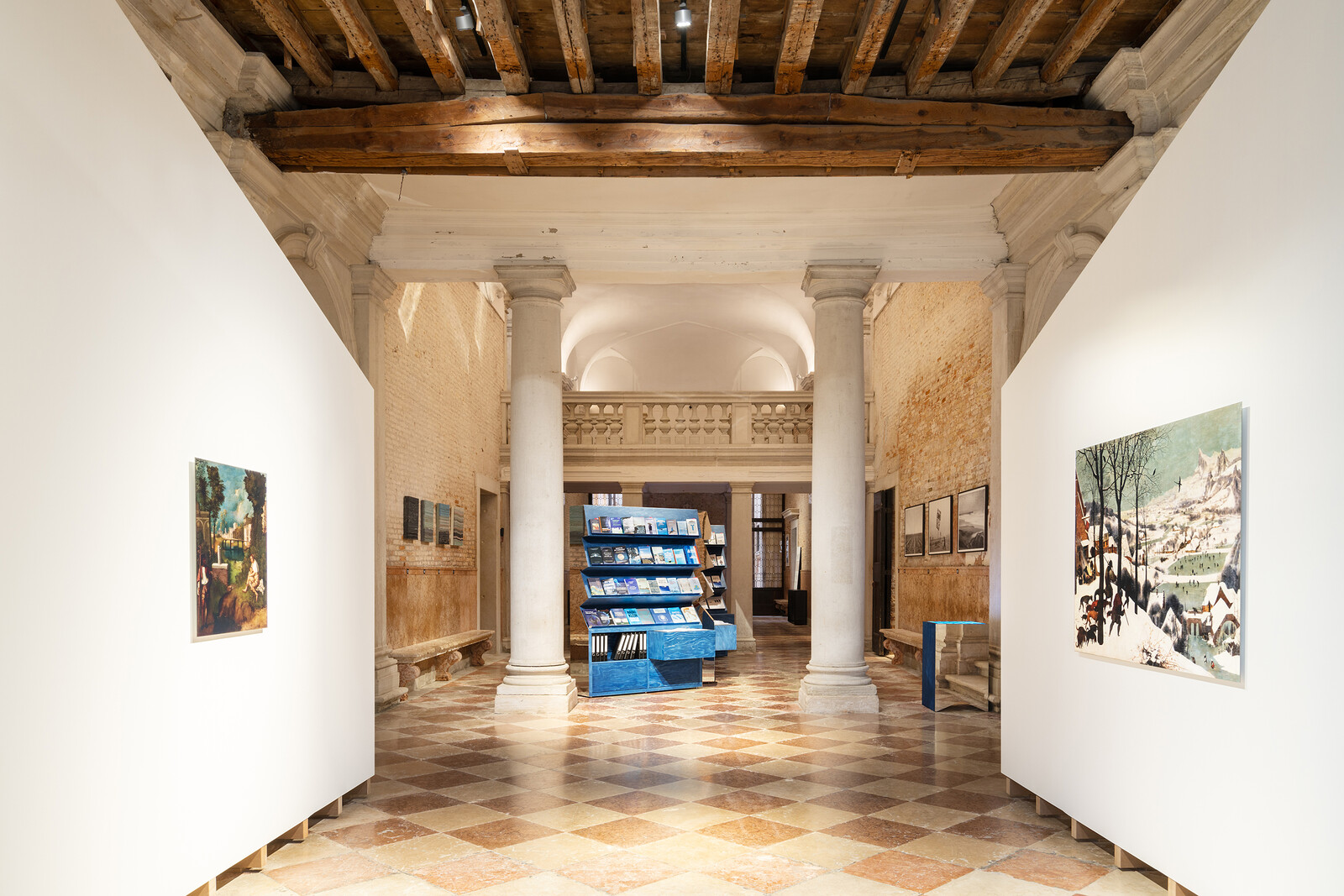One of the most remarkable things about living through a permacrisis is how much seems to go on as normal. Art exhibitions, for example, continue to get organized amid deranging heat, the lurid smoke of forest fires, and the wet wreckage of floods. In Venice, the precarious lagoon city now heavily reliant on a high-tech flood barrier system, two shows are currently on view that propose methods for curating art in this atmosphere of environmental collapse and change.
Weather as metaphor, weather as context, weather as catalyst and catastrophe. There are a lot of exhibition-making strategies being tested in Dieter Roelstraete’s rangy “Everybody Talks About the Weather” at Fondazione Prada, but the show bears some relationship to the “report.” An LED screen with a grid of television weather forecasts from around the world is installed in the foyer, where a collection of glossy professionals with blow-dried hair gesture in front of colorful maps.1 This motif—newsy, mediatic, even a little silly—is echoed in the exhibition’s information panels, which resemble newspaper front pages with headlines, data, and “stories” about the artworks on show. This is the third in a series of major exhibitions across Prada’s venues that have marked a turn towards establishing a shared ground between art and science. Of these, “Everybody Talks About the Weather” is the show that subjects art most profoundly to scientific criteria, casting many works chiefly as containers for information and evidence of climatic phenomena. The approach is instructive, but the arrangement of the works and the infosphere in which they are presented strip artworks of some of their capacities to move a viewer.
The ground floor space is largely devoted to historical works as seen through the long lens of climate change, the centerpiece being an architectural display unit of interconnecting walls, painted in subtle gradations of pale color by Pieter Vermeersch to create the effect of shifting conditions of light and atmosphere. On these walls are hung reproductions (prints on canvas) of masterpieces of meteorological interest: Bruegel’s Hunters in the Snow (Winter) (1565) and J.M.W. Turner’s Rain, Steam, and Speed – The Great Western Railway (1844), with a tabloid-esque panel directing our view to the cloudy plumes caused by acrid coal burning, and ultimately the dawning of fossil-fuel supremacy in the economy. This type of long-view analysis reminds me of the approach to fiction tested in Timothy Clark’s essay “Derangements of Scale” (2012), in which a story—Raymond Carver’s “Elephant” (1988)—is subject to analysis from ever-widening historical viewpoints, including an ecological view of life during a 600-year period.2
At this largest scale, the emphasis moves to mass movements and infrastructures, and the characters’ individual choices or consciousnesses become almost irrelevant, a mode that tends to render humans as uncanny physical “things” stripped away from everyday ethics.3 In the case of the reproduced paintings of Turner et al., unfortunately (and I say this in the knowledge that crating and shipping highly valued originals has a high carbon footprint) the reproductions have a very meagre presence in person. They have lost some human touch, some color, some scale, some of the glowing painterly effects that made them paintings in the first place, which renders the endeavor more of an analytical exercise of images than an experience of art.4
Upstairs are several rooms of works gathered by climate themes, and numerous artistic approaches. Here are artists who have collaborated with the weather in the making of abstract paintings, such as Vivian Suter, who leaves giant unstretched canvases hanging in her garden, to be battered by wind, rain, and sun, or Chantal Peñalosa, who catches ominous traces of ash from the Santa Ana winds on white canvases. There are works connected morphologically, such as a group featuring cloud forms by Vija Celmins, Gerhard Richter, and another work by Peñalosa, who photographs clouds while logging the time it takes to pass across the US/Mexico border. This kind of arrangement has the unfortunate effect of removing the depth of each artist’s endeavor in favor of superficial sameness, perpetuating a kind of alienated, distanced view.
The climate data and graphs that accompany each panel, provided by The New Institute Centre For Environmental Humanities (NICHE) at Ca’ Foscari University also create a scale issue—this time in terms of crisis—by pairing artworks with a major catastrophe about which they can do almost nothing. Walking around an art exhibition, somehow, the data itself even fails to register. A friend once said that looking at climate data only offers an experience of “sheer pain”—we know what these graphs say and the direction that they trend in: honeybees down, heatwaves up. But moving between many smallish artworks made by one person, and the epic scale of extinction statistics, seemed to hurt both causes. Some works, perhaps those most deeply inspired by conditions of peril, spoke forcefully anyway: Jason Dodge’s gemlike dead bees lying where a sculpture should be in a museum display case, or Sophia Al Maria’s ecstatic videos The Future was Desert Part I & II (2016), in which a synthetic alien voice speaks of entering a desert and exiting time.
Across town at San Lorenzo church—the home of TBA21’s Ocean Space—is “Thus waves come in pairs,” another exhibition that has its roots in a long view of climate history. Emerging from a two-year curatorial residency by Barbara Casavecchia on the subject of “The Mediterraneans,” the show used a conversation between Etel Adnan and Simone Fattal as a starting point for site-specific and interdisciplinary research programs including walks, performances, conversations, and field trips around Venice. The culmination of these endeavors comprises two installations, each in one of the two mirrored halves of the church. For Lunar Ensemble for Uprising Seas (2023), Petrit Halilaj and Álvaro Urbano have turned the church into a glimmering seascape overseen by a giant pale egg that hangs from the ceiling. The room is filled with giant metallic sea creatures on stands, each of which is an instrument that can be played, such as gongs and music boxes which are activated in festive community performances. Detailed seagull costumes that the two artists wore for the opening performances, which drew on research about the urban species’ adaptive talents for learning new ways of stealing food from tourists, are also on display. Both installation and the song are parables of transformation in catastrophe, in change, in gender, in species, and offer an unusual glimmer of hope in their emphasis on the ability that living things have to change, and reassemble, under new conditions.
Fattal’s solo contribution, Sempre il mare, uomo libero, amerai! [Free man, you’ll love the ocean endlessy!] (2023), was a quieter, ruminative installation in an atmosphere no less charged. Groups of sculptural works were arranged like islands on the floor of the space, each inscribed with narrative poetics. A number of large, pink pearls made from Murano glass were carved with a story in the Mediterranean lingua franca, a trade language in use around the sea’s ports between the eleventh and nineteenth centuries. The story itself is a disturbing conflict between a sailor and the mother of a young woman he has seduced, in which the sailor threatens the woman and boasts of his powerful connections. Across the room are lumpen, almost primordial figures representing a pair of mythological lovers—Máyya and Ghaylán—competing over their ships in the pearl trade. In the high niches of the church’s altar, a tondo spells out the words γνῶθι σεαυτόν (know thyself), the same ones inscribed on the temple of Apollo at Delphi. The combined effect of elements in the installation created a genuinely profound sense of narrative and catastrophe over a long duration—the “slow violence” of which Rob Nixon has written. The experience of being in this work was a little like drowning sometimes, a little like floating at others. All the beauty and the bloodshed of the sea, so much intimate and large-scale devastation, the changing face of water as a mirror for ourselves, were all pulled together in an ecosystem haunted by an Odysseus-like figure—free man, you’ll love the ocean endlessly.
Artworks can be used as evidence of our impact on the world’s climate, especially where weather is a source of fascination or forms part of a process. Yet so can many cultural objects that reveal a civilization’s fetishes, values, rituals, architectures, and stories. What can art do specifically? To return to the issue of scale, sometimes art’s most important effects, even in times of crisis, are experiences of small communions—an internal change in temperature, or a tightening or relaxing of a shared atmosphere, a sudden feeling of understanding, connecting and so on—that might shift the sensibilities in a microclimate. In order to give these kinds of effects, artworks have to grow out of the deep thinking and complex knowledge of artists about their own positions in a world that is in a state of catastrophe, enormous flux, and (even) potential. They also have to be displayed in a way that allows them to sing. Free man, there is still time to listen to the songs of other sirens.
“Everybody Talks About the Weather” is on view at Fondazione Prada, Venice through November 26. “Thus waves come in pairs” is showing at Ocean Space, Venice through November 5.
Incidentally, this video grid of weather reports is also the way that Groundhog Day – The Musical (2016) opens, introducing its weatherman protagonist, Phil Connors. An unlikely reference, but I, for one, saw it on Broadway.
Timothy Clark, “Derangements of Scale,” in Telemorphosis: Theory in the Era of Climate Change Vol. 1, ed. Tom Cohen (OPEN HUMANITIES PRESS, University of Michigan Library, 2012). I first read about Clark’s essay in Daisy Hildyard’s The Second Body (London, Fitzcarraldo, 2017).
For this reason, Clark suggests applying and maintaining varieties of scale, in search of a layered, “creative derangement” in which more than one conflicting interpretation can hold/have a measure of truth to it.
Fondazione Prada used exhibition copies including 3D prints for many ancient objects in “Human Brains,” which to my inexpert eye worked very well. Reproductions of oil on canvas have a much harder task. I think that either original historical works featured elsewhere in the exhibition, or a form of reproduction that didn’t seem to pretend to be a painting, would have worked better here.







